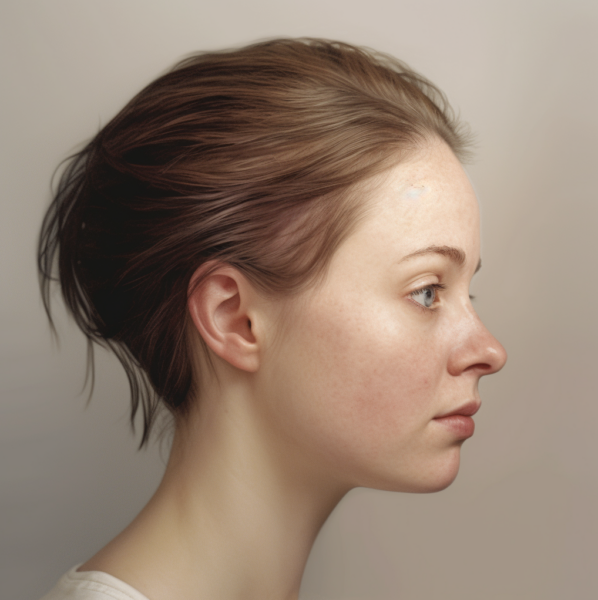Hard water and soft water are terms used to describe the mineral content of water, more specifically the concentration of calcium and magnesium ions. Hard water is characterized by a high concentration of these minerals. This occurs naturally as water moves through soil and rock, absorbing minerals that contain calcium and magnesium. Hard water is not harmful for health, and in fact, it can contribute to daily mineral requirements.
On the other hand, soft water has a low concentration of calcium and magnesium ions. It naturally occurs where rainfall and the geological structure of the ground and soil lead to lower mineral content in the water supply. Soft water can also be the result of a process called water softening, which involves replacing calcium and magnesium ions with sodium ions.
Hard water is a common aspect of many water systems around the world. The effects of hard water on hair have been a subject of interest for researchers, as the interaction between hair and water is a routine part of personal hygiene. A series of studies have examined the impact of hard water on hair strength, structure, and appearance.
One study involved 76 male participants. Water samples from different districts were collected to estimate water hardness. Hair samples were collected from the participants, divided into two groups, and treated with either hard water from the district with maximum hardness or de-ionized water. After 3 months, tensile strength in terms of “stress” was measured. The study concluded that hair treated with hard water had significantly reduced tensile strength compared to hair treated with de-ionized water. The mean values for tensile strength were 238.49 for hair treated with hard water and 255.36 for hair treated with de-ionized water, indicating that hard water may contribute to hair weakening and breakage.
Another study focused on the surface changes of hair due to hard water usage and compared the thickness of hair between hard and soft water-treated samples. Hair strands from 15 healthy female volunteers were washed with either hard water or distilled water for 30 days. The study found that hard water-treated hair had a ruffled appearance, higher mineral deposition, and decreased thickness compared to distilled water-treated hair. Notably, calcium and magnesium deposition was higher in hard water-treated hair.
A third study also focused on tensile strength and involved 70 male participants. Similar to the first study, hair samples were treated with hard water or de-ionized water. The study found that hard water significantly decreased the strength of hair, reinforcing the findings of the first study.
An interesting study examined the interaction between water hardness metals and human hair, focusing on the uptake of calcium and magnesium. It was observed that hair extracts significant levels of these metals during daily hygiene practices. The study demonstrated that hair condition, level of water hardness, and water pH impact the uptake of water hardness metals. Notably, even soft water led to the uptake of water hardness metals, particularly in chemically treated hair. The presence of water hardness metals in hair fibers was found to induce stiffening, which affected hair properties such as combability and style retention.
In contrast, one study indicated that the hardness of water does not interfere with the tensile strength and elasticity of hair. Hair samples were immersed in hard water or distilled water, and tensile strength and elasticity were determined using an INSTRON universal strength tester. The study concluded that there was no statistical significance in the tensile strength and elasticity of hair between the two groups.
Lastly, a study conducted in Saudi Arabia compared structural differences and relative deposition of calcium and magnesium salts on the hair shaft surface between hair treated with hard and soft water. While the study found higher levels of magnesium deposition in samples washed with hard water, it did not find any evident structural surface changes as seen under scanning electron microscopy.
In conclusion, while some studies show that hard water may reduce the tensile strength and alter the surface of hair, others do not find significant changes in tensile strength and elasticity. The discrepancy may be attributed to various factors, including different methodologies and sample sizes. However, it is evident that hard water leads to higher mineral deposition on hair, which may have varying effects depending on individual hair characteristics and conditions. Further studies with more diverse samples and controlled variables are needed to establish a more definitive understanding of the effects of hard water on hair.
Bibliography
11711645 {11711645:SRMVRS35},{11711645:H4EPB5GM},{11711645:DVZK4TII},{11711645:Z83F2Q46},{11711645:V7XQIF2N},{11711645:XZSQSDCT},{11711645:M8AVAARZ} 1 vancouver 50 date asc 201 https://www.keratin.com/wp-content/plugins/zotpress/ %7B%22status%22%3A%22success%22%2C%22updateneeded%22%3Afalse%2C%22instance%22%3Afalse%2C%22meta%22%3A%7B%22request_last%22%3A0%2C%22request_next%22%3A0%2C%22used_cache%22%3Atrue%7D%2C%22data%22%3A%5B%7B%22key%22%3A%22M8AVAARZ%22%2C%22library%22%3A%7B%22id%22%3A11711645%7D%2C%22meta%22%3A%7B%22creatorSummary%22%3A%22Evans%20et%20al.%22%2C%22parsedDate%22%3A%222011%22%2C%22numChildren%22%3A0%7D%2C%22bib%22%3A%22%3Cdiv%20class%3D%5C%22csl-bib-body%5C%22%20style%3D%5C%22line-height%3A%201.35%3B%20%5C%22%3E%5Cn%20%20%3Cdiv%20class%3D%5C%22csl-entry%5C%22%20style%3D%5C%22clear%3A%20left%3B%20%5C%22%3E%5Cn%20%20%20%20%3Cdiv%20class%3D%5C%22csl-left-margin%5C%22%20style%3D%5C%22float%3A%20left%3B%20padding-right%3A%200.5em%3B%20text-align%3A%20right%3B%20width%3A%201em%3B%5C%22%3E1.%3C%5C%2Fdiv%3E%3Cdiv%20class%3D%5C%22csl-right-inline%5C%22%20style%3D%5C%22margin%3A%200%20.4em%200%201.5em%3B%5C%22%3EEvans%20AO%2C%20Marsh%20JM%2C%20Wickett%20RR.%20The%20uptake%20of%20water%20hardness%20metals%20by%20human%20hair.%20J%20Cosmet%20Sci.%202011%3B62%284%29%3A383%26%23x2013%3B91.%3C%5C%2Fdiv%3E%5Cn%20%20%20%3C%5C%2Fdiv%3E%5Cn%3C%5C%2Fdiv%3E%22%2C%22data%22%3A%7B%22itemType%22%3A%22journalArticle%22%2C%22title%22%3A%22The%20uptake%20of%20water%20hardness%20metals%20by%20human%20hair%22%2C%22creators%22%3A%5B%7B%22creatorType%22%3A%22author%22%2C%22firstName%22%3A%22A.%20O.%22%2C%22lastName%22%3A%22Evans%22%7D%2C%7B%22creatorType%22%3A%22author%22%2C%22firstName%22%3A%22J.%20M.%22%2C%22lastName%22%3A%22Marsh%22%7D%2C%7B%22creatorType%22%3A%22author%22%2C%22firstName%22%3A%22R.%20R.%22%2C%22lastName%22%3A%22Wickett%22%7D%5D%2C%22abstractNote%22%3A%22The%20objective%20of%20this%20work%20was%20to%20examine%20the%20variables%20that%20influence%20the%20interaction%20between%20water%20hardness%20metals%20and%20human%20hair.%20Hair%20extracts%20various%20constituents%20from%20the%20tap%20water%20used%20during%20daily%20hygiene%20practices%20and%20chemical%20treatments.%20Calcium%20and%20magnesium%20metal%20ions%20are%20the%20most%20prevalent%20and%20give%20water%20%5C%22hardness.%5C%22%20Inductively%20coupled%20plasma%20atomic%20emission%20spectroscopy%20%28ICP-AES%29%20was%20employed%20to%20quantify%20the%20metal%20content%20of%20hair%2C%20which%20was%20studied%20as%20a%20function%20of%20the%20following%20variables%3A%20hair%20condition%20%28oxidative%20damage%29%2C%20level%20of%20water%20hardness%2C%20and%20water%20pH.%20We%20have%20demonstrated%20that%20these%20variables%20impact%20water%20hardness%20metal%20uptake%20to%20varying%20extents%2C%20and%20the%20effects%20are%20driven%20primarily%20by%20the%20binding%20capacity%20%28available%20anionic%20sites%29%20of%20the%20hair.%20The%20condition%20of%20the%20hair%2C%20a%20key%20representation%20of%20the%20binding%20capacity%2C%20was%20most%20influential.%20Interestingly%2C%20water%20hardness%20levels%20had%20only%20a%20small%20effect%20on%20uptake%3B%20hair%20became%20saturated%20with%20notable%20amounts%20of%20water%20hardness%20metals%20even%20after%20repeated%20exposure%20to%20soft%20water.%20Water%20pH%20influenced%20metal%20uptake%20since%20side%20chains%20of%20hair%20proteins%20deprotonate%20with%20increasing%20alkalinity.%20These%20insights%20highlight%20the%20importance%20to%20the%20hair%20care%20industry%20of%20understanding%20the%20interaction%20between%20water%20hardness%20metals%20and%20hair.%22%2C%22date%22%3A%222011%22%2C%22language%22%3A%22eng%22%2C%22DOI%22%3A%22%22%2C%22ISSN%22%3A%221525-7886%22%2C%22url%22%3A%22%22%2C%22collections%22%3A%5B%22JHQMDQAA%22%5D%2C%22dateModified%22%3A%222023-06-18T15%3A44%3A11Z%22%7D%7D%2C%7B%22key%22%3A%22XZSQSDCT%22%2C%22library%22%3A%7B%22id%22%3A11711645%7D%2C%22meta%22%3A%7B%22creatorSummary%22%3A%22Evans%20et%20al.%22%2C%22parsedDate%22%3A%222011-10%22%2C%22numChildren%22%3A0%7D%2C%22bib%22%3A%22%3Cdiv%20class%3D%5C%22csl-bib-body%5C%22%20style%3D%5C%22line-height%3A%201.35%3B%20%5C%22%3E%5Cn%20%20%3Cdiv%20class%3D%5C%22csl-entry%5C%22%20style%3D%5C%22clear%3A%20left%3B%20%5C%22%3E%5Cn%20%20%20%20%3Cdiv%20class%3D%5C%22csl-left-margin%5C%22%20style%3D%5C%22float%3A%20left%3B%20padding-right%3A%200.5em%3B%20text-align%3A%20right%3B%20width%3A%201em%3B%5C%22%3E1.%3C%5C%2Fdiv%3E%3Cdiv%20class%3D%5C%22csl-right-inline%5C%22%20style%3D%5C%22margin%3A%200%20.4em%200%201.5em%3B%5C%22%3EEvans%20AO%2C%20Marsh%20JM%2C%20Wickett%20RR.%20The%20structural%20implications%20of%20water%20hardness%20metal%20uptake%20by%20human%20hair.%20Int%20J%20Cosmet%20Sci.%202011%20Oct%3B33%285%29%3A477%26%23x2013%3B82.%3C%5C%2Fdiv%3E%5Cn%20%20%20%3C%5C%2Fdiv%3E%5Cn%3C%5C%2Fdiv%3E%22%2C%22data%22%3A%7B%22itemType%22%3A%22journalArticle%22%2C%22title%22%3A%22The%20structural%20implications%20of%20water%20hardness%20metal%20uptake%20by%20human%20hair%22%2C%22creators%22%3A%5B%7B%22creatorType%22%3A%22author%22%2C%22firstName%22%3A%22A.%20O.%22%2C%22lastName%22%3A%22Evans%22%7D%2C%7B%22creatorType%22%3A%22author%22%2C%22firstName%22%3A%22J.%20M.%22%2C%22lastName%22%3A%22Marsh%22%7D%2C%7B%22creatorType%22%3A%22author%22%2C%22firstName%22%3A%22R.%20R.%22%2C%22lastName%22%3A%22Wickett%22%7D%5D%2C%22abstractNote%22%3A%22Human%20hair%20can%20extract%20significant%20levels%20of%20calcium%20and%20magnesium%2C%20water%20hardness%20metals%2C%20from%20tap%20water%20immediately%20following%20chemical%20treatments%20and%20during%20hygiene%20practices.%20We%20have%20previously%20shown%20that%20this%20uptake%20is%20primarily%20a%20function%20of%20the%20condition%20of%20the%20hair.%20Depending%20on%20the%20extent%20of%20chemical%20damage%2C%20the%20hair%20can%20extract%20notable%20amounts%20of%20water%20hardness%20metals%20even%20from%20soft%20water.%20As%20water%20hardness%20metals%20concentrate%20primarily%20in%20the%20cuticle%20layers%20of%20the%20hair%20fibre%2C%20it%20is%20hypothesized%20that%20their%20presence%20will%20affect%20the%20structural%20properties%20that%20are%20chiefly%20driven%20by%20the%20cuticle.%20We%20examined%20hair%20mechanics%20and%20styling%20by%20technical%20measures%20of%20single-fibre%20torsional%20and%20tensile%20properties%2C%20combability%20and%20style%20retention%20as%20a%20function%20of%20the%20calcium%20and%20magnesium%20content%20of%20virgin%20and%20bleached%20hair.%20Our%20work%20has%20indicated%20that%20water%20hardness%20can%20affect%20hair%20properties.%20Fibre%20stiffening%20was%20induced%20by%20the%20presence%20of%20water%20hardness%20metals%20inside%20the%20fibres%20of%20both%20virgin%20and%20bleached%20hair.%20A%20reduction%20in%20combing%20forces%20was%20also%20observed%2C%20and%20this%20effect%20is%20believed%20to%20be%20a%20result%20of%20the%20stiffening.%20The%20style%20retention%20of%20virgin%20hair%20was%20improved%20by%20water%20hardness%20metals%2C%20whereas%20that%20of%20bleached%20hair%20was%20slightly%20reduced.%22%2C%22date%22%3A%222011-10%22%2C%22language%22%3A%22eng%22%2C%22DOI%22%3A%2210.1111%5C%2Fj.1468-2494.2011.00659.x%22%2C%22ISSN%22%3A%221468-2494%22%2C%22url%22%3A%22%22%2C%22collections%22%3A%5B%22JHQMDQAA%22%5D%2C%22dateModified%22%3A%222023-06-18T15%3A44%3A40Z%22%7D%7D%2C%7B%22key%22%3A%22DVZK4TII%22%2C%22library%22%3A%7B%22id%22%3A11711645%7D%2C%22meta%22%3A%7B%22creatorSummary%22%3A%22Srinivasan%20et%20al.%22%2C%22parsedDate%22%3A%222013-07%22%2C%22numChildren%22%3A0%7D%2C%22bib%22%3A%22%3Cdiv%20class%3D%5C%22csl-bib-body%5C%22%20style%3D%5C%22line-height%3A%201.35%3B%20%5C%22%3E%5Cn%20%20%3Cdiv%20class%3D%5C%22csl-entry%5C%22%20style%3D%5C%22clear%3A%20left%3B%20%5C%22%3E%5Cn%20%20%20%20%3Cdiv%20class%3D%5C%22csl-left-margin%5C%22%20style%3D%5C%22float%3A%20left%3B%20padding-right%3A%200.5em%3B%20text-align%3A%20right%3B%20width%3A%201em%3B%5C%22%3E1.%3C%5C%2Fdiv%3E%3Cdiv%20class%3D%5C%22csl-right-inline%5C%22%20style%3D%5C%22margin%3A%200%20.4em%200%201.5em%3B%5C%22%3ESrinivasan%20G%2C%20Srinivas%20CR%2C%20Mathew%20AC%2C%20Duraiswami%20D.%20Effects%20of%20hard%20water%20on%20hair.%20Int%20J%20Trichology.%202013%20Jul%3B5%283%29%3A137%26%23x2013%3B9.%3C%5C%2Fdiv%3E%5Cn%20%20%20%3C%5C%2Fdiv%3E%5Cn%3C%5C%2Fdiv%3E%22%2C%22data%22%3A%7B%22itemType%22%3A%22journalArticle%22%2C%22title%22%3A%22Effects%20of%20hard%20water%20on%20hair%22%2C%22creators%22%3A%5B%7B%22creatorType%22%3A%22author%22%2C%22firstName%22%3A%22Gautham%22%2C%22lastName%22%3A%22Srinivasan%22%7D%2C%7B%22creatorType%22%3A%22author%22%2C%22firstName%22%3A%22Chakravarthi%20Rangachari%22%2C%22lastName%22%3A%22Srinivas%22%7D%2C%7B%22creatorType%22%3A%22author%22%2C%22firstName%22%3A%22Anil%20C.%22%2C%22lastName%22%3A%22Mathew%22%7D%2C%7B%22creatorType%22%3A%22author%22%2C%22firstName%22%3A%22Divakar%22%2C%22lastName%22%3A%22Duraiswami%22%7D%5D%2C%22abstractNote%22%3A%22BACKGROUND%3A%20Hardness%20of%20water%20is%20determined%20by%20the%20amount%20of%20salts%20%28calcium%20carbonate%20%5BCaCO3%5D%20and%20magnesium%20sulphate%20%5BMgSO4%5D%29%20present%20in%20water.%20The%20hardness%20of%20the%20water%20used%20for%20washing%20hair%20may%20cause%20fragility%20of%20hair.%5CnOBJECTIVE%3A%20The%20objective%20of%20the%20following%20study%20is%20to%20compare%20the%20tensile%20strength%20and%20elasticity%20of%20hair%20treated%20in%20hard%20water%20and%20hair%20treated%20in%20distilled%20water.%5CnMATERIALS%20AND%20METHODS%3A%2010-15%20strands%20of%20hair%20of%20length%2015-20%20cm%2C%20lost%20during%20combing%20were%20obtained%20from%2015%20volunteers.%20Each%20sample%20was%20cut%20in%20the%20middle%20to%20obtain%202%20sets%20of%20hair%20per%20volunteer.%20One%20set%20of%2015%20samples%20was%20immersed%20in%20hard%20water%20and%20the%20other%20set%20in%20distilled%20water%20for%2010%20min%20on%20alternate%20days.%20Procedure%20was%20repeated%20for%2030%20days.%20The%20tensile%20strength%20and%20elasticity%20of%20the%20hair%20treated%20in%20hard%20water%20and%20distilled%20water%20was%20determined%20using%20INSTRON%20universal%20strength%20tester.%5CnRESULTS%3A%20The%20CaCO3%20and%20MgSO4%20content%20of%20hard%20water%20and%20distilled%20water%20were%20determined%20as%20212.5%20ppm%20of%20CaCO3%20and%2010%20ppm%20of%20CaCO3%20respectively.%20The%20tensile%20strength%20and%20elasticity%20in%20each%20sample%20was%20determined%20and%20the%20mean%20values%20were%20compared%20using%20t-test.%20The%20mean%20%28SD%29%20of%20tensile%20strength%20of%20hair%20treated%20in%20hard%20water%20was%20105.28%20%2827.59%29%20and%20in%20distilled%20water%20was%20103.66%20%2820.92%29.%20No%20statistical%20significance%20was%20observed%20in%20the%20tensile%20strength%2C%20t%20%3D%200.181%2C%20P%20%3D%200.858.%20The%20mean%20%28SD%29%20of%20elasticity%20of%20hair%20treated%20in%20hard%20water%20was%2037.06%20%282.24%29%20and%20in%20distilled%20water%20was%2036.84%20%284.8%29.%20No%20statistical%20significance%20was%20observed%20in%20the%20elasticity%2C%20t%20%3D%200.161%2C%20P%20%3D%200.874.%5CnCONCLUSION%3A%20The%20hardness%20of%20water%20does%20not%20interfere%20with%20the%20tensile%20strength%20and%20elasticity%20of%20hair.%22%2C%22date%22%3A%222013-07%22%2C%22language%22%3A%22eng%22%2C%22DOI%22%3A%2210.4103%5C%2F0974-7753.125609%22%2C%22ISSN%22%3A%220974-7753%22%2C%22url%22%3A%22%22%2C%22collections%22%3A%5B%22JHQMDQAA%22%5D%2C%22dateModified%22%3A%222023-06-18T15%3A45%3A16Z%22%7D%7D%2C%7B%22key%22%3A%22Z83F2Q46%22%2C%22library%22%3A%7B%22id%22%3A11711645%7D%2C%22meta%22%3A%7B%22creatorSummary%22%3A%22Srinivasan%20and%20Chakravarthy%20Rangachari%22%2C%22parsedDate%22%3A%222016-06%22%2C%22numChildren%22%3A0%7D%2C%22bib%22%3A%22%3Cdiv%20class%3D%5C%22csl-bib-body%5C%22%20style%3D%5C%22line-height%3A%201.35%3B%20%5C%22%3E%5Cn%20%20%3Cdiv%20class%3D%5C%22csl-entry%5C%22%20style%3D%5C%22clear%3A%20left%3B%20%5C%22%3E%5Cn%20%20%20%20%3Cdiv%20class%3D%5C%22csl-left-margin%5C%22%20style%3D%5C%22float%3A%20left%3B%20padding-right%3A%200.5em%3B%20text-align%3A%20right%3B%20width%3A%201em%3B%5C%22%3E1.%3C%5C%2Fdiv%3E%3Cdiv%20class%3D%5C%22csl-right-inline%5C%22%20style%3D%5C%22margin%3A%200%20.4em%200%201.5em%3B%5C%22%3ESrinivasan%20G%2C%20Chakravarthy%20Rangachari%20S.%20Scanning%20electron%20microscopy%20of%20hair%20treated%20in%20hard%20water.%20Int%20J%20Dermatol.%202016%20Jun%3B55%286%29%3Ae344-346.%3C%5C%2Fdiv%3E%5Cn%20%20%20%3C%5C%2Fdiv%3E%5Cn%3C%5C%2Fdiv%3E%22%2C%22data%22%3A%7B%22itemType%22%3A%22journalArticle%22%2C%22title%22%3A%22Scanning%20electron%20microscopy%20of%20hair%20treated%20in%20hard%20water%22%2C%22creators%22%3A%5B%7B%22creatorType%22%3A%22author%22%2C%22firstName%22%3A%22Gautham%22%2C%22lastName%22%3A%22Srinivasan%22%7D%2C%7B%22creatorType%22%3A%22author%22%2C%22firstName%22%3A%22Srinivas%22%2C%22lastName%22%3A%22Chakravarthy%20Rangachari%22%7D%5D%2C%22abstractNote%22%3A%22BACKGROUND%3A%20Hardness%20of%20water%20is%20determined%20by%20the%20amount%20of%20calcium%20carbonate%20%28CaCO3%20%29%20and%20magnesium%20sulfate%20%28MgSO4%20%29%20dissolved%20in%20it.%20Hardness%20of%20water%20used%20for%20washing%20hair%20may%20damage%20the%20hair.%5CnOBJECTIVES%3A%20The%20objective%20of%20this%20study%20is%20to%20observe%20the%20surface%20changes%20due%20to%20hard%20water%20usage%20and%20compare%20the%20thickness%20of%20hair%20between%20hard%20and%20soft%20water%20treated%20samples.%5CnMETHODS%3A%20Ten%20to%2015%20hair%20strands%20of%20length%2015-20%20cm%2C%20which%20were%20lost%20during%20combing%2C%20were%20obtained%20from%2015%20healthy%20female%20volunteers.%20Each%20hair%20sample%20was%20cut%20into%20two%20equal%20halves%20to%20obtain%20two%20sets%20per%20volunteer.%20Each%20hair%20sample%20was%20wrapped%20around%20a%20glass%20rod.%20One%20set%20of%2015%20samples%20was%20washed%20with%20hard%20water%2C%20and%20the%20other%20set%20was%20washed%20with%20distilled%20water%20for%2010%20minutes%20on%20alternate%20days%20and%20air-dried.%20This%20procedure%20was%20carried%20out%20for%2030%20days.%20The%20surface%20of%20hair%20treated%20in%20hard%20and%20soft%20water%20was%20examined%20under%20a%20scanning%20electron%20microscope.%5CnRESULTS%3A%20The%20CaCO3%20and%20MgSO4%20content%20of%20hard%20and%20distilled%20water%20samples%20were%20determined%20as%20212.5%20ppm%20of%20CaCO3%20and%2010%20ppm%20of%20CaCO3%20respectively.%20The%20mean%20calcium%20deposition%20in%20hard%20and%20distilled%20water%20treated%20hair%20was%20determined%20as%200.804%25%20and%200.26%25%2C%20respectively.%20The%20mean%20magnesium%20deposition%20in%20hard%20and%20distilled%20water%20treated%20hair%20was%20determined%20as%200.34%25%20and%200.078%25%2C%20respectively.%20The%20mean%20thickness%20of%20hair%20treated%20in%20hard%20water%20and%20distilled%20water%20were%2072.78%20and%2078.14%20%5Cu03bcm%2C%20respectively.%5CnCONCLUSION%3A%20The%20surface%20of%20hard%20water%20treated%20hair%20has%20a%20ruffled%20appearance%20with%20higher%20mineral%20deposition%20and%20decreased%20thickness%20when%20compared%20with%20the%20surface%20of%20distilled%20water%20treated%20hair.%22%2C%22date%22%3A%222016-06%22%2C%22language%22%3A%22eng%22%2C%22DOI%22%3A%2210.1111%5C%2Fijd.13141%22%2C%22ISSN%22%3A%221365-4632%22%2C%22url%22%3A%22%22%2C%22collections%22%3A%5B%22JHQMDQAA%22%5D%2C%22dateModified%22%3A%222023-06-18T15%3A42%3A53Z%22%7D%7D%2C%7B%22key%22%3A%22H4EPB5GM%22%2C%22library%22%3A%7B%22id%22%3A11711645%7D%2C%22meta%22%3A%7B%22creatorSummary%22%3A%22Luqman%20et%20al.%22%2C%22parsedDate%22%3A%222016-09%22%2C%22numChildren%22%3A0%7D%2C%22bib%22%3A%22%3Cdiv%20class%3D%5C%22csl-bib-body%5C%22%20style%3D%5C%22line-height%3A%201.35%3B%20%5C%22%3E%5Cn%20%20%3Cdiv%20class%3D%5C%22csl-entry%5C%22%20style%3D%5C%22clear%3A%20left%3B%20%5C%22%3E%5Cn%20%20%20%20%3Cdiv%20class%3D%5C%22csl-left-margin%5C%22%20style%3D%5C%22float%3A%20left%3B%20padding-right%3A%200.5em%3B%20text-align%3A%20right%3B%20width%3A%201em%3B%5C%22%3E1.%3C%5C%2Fdiv%3E%3Cdiv%20class%3D%5C%22csl-right-inline%5C%22%20style%3D%5C%22margin%3A%200%20.4em%200%201.5em%3B%5C%22%3ELuqman%20MW%2C%20Ali%20R%2C%20Khan%20Z%2C%20Ramzan%20MH%2C%20Hanan%20F%2C%20Javaid%20U.%20Effect%20of%20topical%20application%20of%20hard%20water%20in%20weakening%20of%20hair%20in%20men.%20J%20Pak%20Med%20Assoc.%202016%20Sep%3B66%289%29%3A1132%26%23x2013%3B6.%3C%5C%2Fdiv%3E%5Cn%20%20%20%3C%5C%2Fdiv%3E%5Cn%3C%5C%2Fdiv%3E%22%2C%22data%22%3A%7B%22itemType%22%3A%22journalArticle%22%2C%22title%22%3A%22Effect%20of%20topical%20application%20of%20hard%20water%20in%20weakening%20of%20hair%20in%20men%22%2C%22creators%22%3A%5B%7B%22creatorType%22%3A%22author%22%2C%22firstName%22%3A%22Muhammad%20Waqas%22%2C%22lastName%22%3A%22Luqman%22%7D%2C%7B%22creatorType%22%3A%22author%22%2C%22firstName%22%3A%22Roshan%22%2C%22lastName%22%3A%22Ali%22%7D%2C%7B%22creatorType%22%3A%22author%22%2C%22firstName%22%3A%22Zahid%22%2C%22lastName%22%3A%22Khan%22%7D%2C%7B%22creatorType%22%3A%22author%22%2C%22firstName%22%3A%22Muhammad%20Haris%22%2C%22lastName%22%3A%22Ramzan%22%7D%2C%7B%22creatorType%22%3A%22author%22%2C%22firstName%22%3A%22Fazal%22%2C%22lastName%22%3A%22Hanan%22%7D%2C%7B%22creatorType%22%3A%22author%22%2C%22firstName%22%3A%22Usama%22%2C%22lastName%22%3A%22Javaid%22%7D%5D%2C%22abstractNote%22%3A%22BACKGROUND%3A%20Hard%20water%20is%20thought%20to%20play%20a%20key%20role%20in%20weakening%20of%20hair%20%28not%20Hair%20Loss%29%20and%20breakage%20especially%20when%20travelling%20is%20involved.%20In%20our%20community%2C%20commonly%20men%20do%20the%20travelling%20and%20complain%20more%20about%20hair%20problem%20which%20is%20why%20only%20young%20male%20individuals%20were%20included%20in%20this%20study.%5CnMATERIALS%20AND%20METHODS%3A%20Water%20samples%20from%20different%20districts%20of%20KPK%2C%20Pakistan%2C%20were%20collected%20and%20their%20hardness%20values%20were%20estimated%20to%20find%20the%20water%20sample%20of%20maximum%20and%20minimum%20water%20hardness%20in%20order%20to%20know%20the%20maximum%20hardness%20hair%20would%20encounter%20in%20KPK%2C%20Pakistan.%20Samples%20from%20district%20Kohat%20had%20maximum%20hardness%20whereas%20minimum%20hardness%20was%20estimated%20in%20samples%20of%20district%20Peshawar.%20Water%20from%20district%20Kohat%20was%20considered%20as%20our%20sample%20water%20for%20the%20experimental%20group%20of%20hair.%20Hair%20samples%20were%20collected%20from%2076%20male%20individuals%20of%20district%20Peshawar%2C%20the%20area%20with%20least%20water%20hardness%20among%20the%20samples%20collected.%20Each%20hair%20sample%20was%20divided%20into%20two%20halves.%20One%20half%20was%20considered%20as%20experimental%20group%20and%20the%20other%20was%20considered%20as%20control%20group.%20The%20experimental%20group%20was%20treated%20with%20hard%20water%20of%20district%20Kohat%20for%2010%20minutes%20on%20alternate%20days%2C%20for%203%20months.%20In%20a%20very%20similar%20way%20the%20control%20group%20was%20treated%20with%20de-ionized%20water.%20Tensile%20strength%20in%20term%20of%20%5C%22Stress%5C%22%20of%20both%20the%20experimental%20and%20control%20groups%20were%20measured%20using%20the%20universal%20testing%20machine%20and%20compared%20using%20paired%20t-test.%5CnRESULTS%20AND%20CONCLUSIONS%3A%20The%20standard%20deviations%20%28SD%29%20for%20hair%20treated%20with%20hard%20water%20and%20distilled%20water%20was%2062.05%20and%2058.13%20respectively%20and%20the%20mean%20values%20were%20238.49%20and%20255.36%20respectively.%20The%20results%20showed%20that%20the%20tensile%20strength%20of%20hair%20was%20significantly%20%28p%3D0.001%29%20reduced%20in%20hair%20treated%20with%20hard%20water%20as%20compared%20to%20hair%20treated%20with%20de-ionized%20water.%22%2C%22date%22%3A%222016-09%22%2C%22language%22%3A%22eng%22%2C%22DOI%22%3A%22%22%2C%22ISSN%22%3A%220030-9982%22%2C%22url%22%3A%22%22%2C%22collections%22%3A%5B%22JHQMDQAA%22%5D%2C%22dateModified%22%3A%222023-06-18T15%3A41%3A41Z%22%7D%7D%2C%7B%22key%22%3A%22V7XQIF2N%22%2C%22library%22%3A%7B%22id%22%3A11711645%7D%2C%22meta%22%3A%7B%22creatorSummary%22%3A%22Alahmmed%20et%20al.%22%2C%22parsedDate%22%3A%222017%22%2C%22numChildren%22%3A0%7D%2C%22bib%22%3A%22%3Cdiv%20class%3D%5C%22csl-bib-body%5C%22%20style%3D%5C%22line-height%3A%201.35%3B%20%5C%22%3E%5Cn%20%20%3Cdiv%20class%3D%5C%22csl-entry%5C%22%20style%3D%5C%22clear%3A%20left%3B%20%5C%22%3E%5Cn%20%20%20%20%3Cdiv%20class%3D%5C%22csl-left-margin%5C%22%20style%3D%5C%22float%3A%20left%3B%20padding-right%3A%200.5em%3B%20text-align%3A%20right%3B%20width%3A%201em%3B%5C%22%3E1.%3C%5C%2Fdiv%3E%3Cdiv%20class%3D%5C%22csl-right-inline%5C%22%20style%3D%5C%22margin%3A%200%20.4em%200%201.5em%3B%5C%22%3EAlahmmed%20LM%2C%20Alibrahim%20EA%2C%20Alkhars%20AF%2C%20Almulhim%20MN%2C%20Ali%20SI%2C%20Kaliyadan%20F.%20Scanning%20electron%20microscopy%20study%20of%20hair%20shaft%20changes%20related%20to%20hardness%20of%20water.%20Indian%20J%20Dermatol%20Venereol%20Leprol.%202017%3B83%286%29%3A740.%3C%5C%2Fdiv%3E%5Cn%20%20%20%3C%5C%2Fdiv%3E%5Cn%3C%5C%2Fdiv%3E%22%2C%22data%22%3A%7B%22itemType%22%3A%22journalArticle%22%2C%22title%22%3A%22Scanning%20electron%20microscopy%20study%20of%20hair%20shaft%20changes%20related%20to%20hardness%20of%20water%22%2C%22creators%22%3A%5B%7B%22creatorType%22%3A%22author%22%2C%22firstName%22%3A%22Lujain%20M.%22%2C%22lastName%22%3A%22Alahmmed%22%7D%2C%7B%22creatorType%22%3A%22author%22%2C%22firstName%22%3A%22Ebtehal%20A.%22%2C%22lastName%22%3A%22Alibrahim%22%7D%2C%7B%22creatorType%22%3A%22author%22%2C%22firstName%22%3A%22Abdullah%20F.%22%2C%22lastName%22%3A%22Alkhars%22%7D%2C%7B%22creatorType%22%3A%22author%22%2C%22firstName%22%3A%22Mohammed%20N.%22%2C%22lastName%22%3A%22Almulhim%22%7D%2C%7B%22creatorType%22%3A%22author%22%2C%22firstName%22%3A%22Sayed%20Ibrahim%22%2C%22lastName%22%3A%22Ali%22%7D%2C%7B%22creatorType%22%3A%22author%22%2C%22firstName%22%3A%22Feroze%22%2C%22lastName%22%3A%22Kaliyadan%22%7D%5D%2C%22abstractNote%22%3A%22INTRODUCTION%20AND%20AIMS%3A%20Brittleness%20and%20breakage%20of%20hair%20is%20a%20common%20complaint%20in%20the%20geographical%20area%20of%20Saudi%20Arabia%20where%20we%20work.%20This%20area%20has%20a%20high%20level%20of%20hardness%20in%20normal%20tap%20water.%20We%20aimed%20to%20study%20and%20compare%20structural%20differences%20and%20relative%20deposition%20of%20calcium%20and%20magnesium%20salts%20on%20the%20hair%20shaft%20surface%20using%20scanning%20electron%20microscopy%20%28SEM%29%20between%20hair%20shaft%20samples%20from%20normal%2C%20healthy%20volunteers%20treated%20with%20hard%20and%20soft%20water.%5CnMETHODS%3A%20Hair%20samples%20obtained%20from%2020%20healthy%20volunteers%20were%20divided%20into%20two%20groups.%20One%20group%20was%20treated%20with%20hard%20water%20for%203%20weeks%20and%20the%20second%20with%20soft%20water%20for%20the%20same%20duration.%20SEM%20was%20used%20to%20assess%20hair%20shaft%20surface%20damages%20and%20relative%20deposition%20of%20calcium%20and%20magnesium%20on%20the%20surface%20of%20the%20hair.%5CnRESULTS%3A%20There%20was%20no%20statistically%20significant%20difference%20between%20the%20study%20and%20control%20group%20as%20far%20as%20surface%20changes%20under%20SEM%20were%20concerned.%20As%20far%20as%20the%20relative%20deposition%20of%20calcium%20and%20magnesium%20was%20concerned%2C%20there%20was%20no%20statistically%20significant%20difference%20in%20calcium%20deposition%20between%20the%20control%20and%20study%20samples%20%28P%20%3D%200.28%29.%20On%20the%20other%20hand%2C%20magnesium%20deposition%20showed%20a%20significant%20difference%20between%20both%20groups%20%28P%20%3D%200.001%29%2C%20with%20a%20higher%20level%20in%20samples%20washed%20with%20hard%20water.%5CnCONCLUSIONS%3A%20Hard%20water%20may%20be%20associated%20with%20increased%20deposits%20on%20the%20hair%20shaft%20surface%2C%20however%2C%20this%20does%20not%20necessarily%20translate%20into%20evident%20structural%20surface%20changes%2C%20as%20evidenced%20by%20SEM.%22%2C%22date%22%3A%222017%22%2C%22language%22%3A%22eng%22%2C%22DOI%22%3A%2210.4103%5C%2Fijdvl.IJDVL_1119_16%22%2C%22ISSN%22%3A%220973-3922%22%2C%22url%22%3A%22%22%2C%22collections%22%3A%5B%22JHQMDQAA%22%5D%2C%22dateModified%22%3A%222023-06-18T15%3A45%3A53Z%22%7D%7D%2C%7B%22key%22%3A%22SRMVRS35%22%2C%22library%22%3A%7B%22id%22%3A11711645%7D%2C%22meta%22%3A%7B%22creatorSummary%22%3A%22Luqman%20et%20al.%22%2C%22parsedDate%22%3A%222018%22%2C%22numChildren%22%3A0%7D%2C%22bib%22%3A%22%3Cdiv%20class%3D%5C%22csl-bib-body%5C%22%20style%3D%5C%22line-height%3A%201.35%3B%20%5C%22%3E%5Cn%20%20%3Cdiv%20class%3D%5C%22csl-entry%5C%22%20style%3D%5C%22clear%3A%20left%3B%20%5C%22%3E%5Cn%20%20%20%20%3Cdiv%20class%3D%5C%22csl-left-margin%5C%22%20style%3D%5C%22float%3A%20left%3B%20padding-right%3A%200.5em%3B%20text-align%3A%20right%3B%20width%3A%201em%3B%5C%22%3E1.%3C%5C%2Fdiv%3E%3Cdiv%20class%3D%5C%22csl-right-inline%5C%22%20style%3D%5C%22margin%3A%200%20.4em%200%201.5em%3B%5C%22%3ELuqman%20MW%2C%20Ramzan%20MH%2C%20Javaid%20U%2C%20Ali%20R%2C%20Shoaib%20M%2C%20Luqman%20MA.%20To%20Evaluate%20and%20Compare%20Changes%20in%20Baseline%20Strength%20of%20Hairs%20after%20Treating%20them%20with%20Deionized%20Water%20and%20Hard%20Water%20and%20its%20Role%20in%20Hair%20Breakage.%20Int%20J%20Trichology.%202018%3B10%283%29%3A113%26%23x2013%3B7.%3C%5C%2Fdiv%3E%5Cn%20%20%20%3C%5C%2Fdiv%3E%5Cn%3C%5C%2Fdiv%3E%22%2C%22data%22%3A%7B%22itemType%22%3A%22journalArticle%22%2C%22title%22%3A%22To%20Evaluate%20and%20Compare%20Changes%20in%20Baseline%20Strength%20of%20Hairs%20after%20Treating%20them%20with%20Deionized%20Water%20and%20Hard%20Water%20and%20its%20Role%20in%20Hair%20Breakage%22%2C%22creators%22%3A%5B%7B%22creatorType%22%3A%22author%22%2C%22firstName%22%3A%22Muhammad%20Waqas%22%2C%22lastName%22%3A%22Luqman%22%7D%2C%7B%22creatorType%22%3A%22author%22%2C%22firstName%22%3A%22Muhammad%20Haris%22%2C%22lastName%22%3A%22Ramzan%22%7D%2C%7B%22creatorType%22%3A%22author%22%2C%22firstName%22%3A%22Usama%22%2C%22lastName%22%3A%22Javaid%22%7D%2C%7B%22creatorType%22%3A%22author%22%2C%22firstName%22%3A%22Roshan%22%2C%22lastName%22%3A%22Ali%22%7D%2C%7B%22creatorType%22%3A%22author%22%2C%22firstName%22%3A%22Muhammad%22%2C%22lastName%22%3A%22Shoaib%22%7D%2C%7B%22creatorType%22%3A%22author%22%2C%22firstName%22%3A%22Muhammad%20Ayyas%22%2C%22lastName%22%3A%22Luqman%22%7D%5D%2C%22abstractNote%22%3A%22BACKGROUND%20AND%20AIM%3A%20Interaction%20of%20hair%20with%20water%20is%20common.%20This%20study%20was%20conducted%20to%20compare%20changes%20in%20baseline%20strength%20of%20hair%20after%20treating%20it%20with%20hard%20water%20and%20deionized%20water.%5CnMATERIAL%20AND%20METHODS%3A%20Hardness%20level%20of%20water%20samples%20collected%20from%2010%20districts%20of%20KP%2C%20Pakistan%20was%20determined%2C%20and%20that%20with%20maximum%20hardness%20was%20considered%20our%20sample%20hard%20water.%20Hair%20samples%20of%2070%20male%20individuals%2C%20from%20district%20with%20minimum%20hardness%20levels%2C%20were%20collected.%20Each%20hair%20sample%20was%20divided%20into%20three%20equal%20parts%2C%20and%20three%20groups%20of%20hair%20were%20established%2C%20each%20group%20containing%2070%20hairs.%20Group%20A%20was%20considered%20control.%20Group%20B%20was%20treated%20with%20deionized%20water%20and%20Group%20C%20was%20treated%20with%20hard%20water.%20Tensile%20strength%20of%20all%20three%20groups%20was%20measured%20using%20the%20universal%20testing%20machine%20and%20compared%20using%20paired%20t-test.%5CnRESULTS%3A%20The%20mean%20age%20of%20all%2070%20participants%20were%2023.87%20%5Cu00b1%203.%20The%20mean%20values%20of%20tensile%20strength%20for%20hairs%20of%20Groups%20A%2C%20B%2C%20and%20C%20were%20255.49%2C%20254.84%2C%20and%20234.16%20with%20a%20standard%20deviation%20of%2057.55%2C%2058.74%2C%20and%2056.25%2C%20respectively.%20Results%20were%20significant%20in%20case%20of%20hard%20water%20%28P%20%3D%200.001%29%20as%20compared%20to%20deionized%20water%20%28P%20%3D%200.609%29.%5CnCONCLUSION%3A%20Hard%20water%20decreases%20strength%20of%20hair%20and%20thus%20increases%20breakage.%22%2C%22date%22%3A%222018%22%2C%22language%22%3A%22eng%22%2C%22DOI%22%3A%2210.4103%5C%2Fijt.ijt_115_16%22%2C%22ISSN%22%3A%220974-7753%22%2C%22url%22%3A%22%22%2C%22collections%22%3A%5B%22JHQMDQAA%22%5D%2C%22dateModified%22%3A%222023-06-18T15%3A43%3A39Z%22%7D%7D%5D%7D 1.
Evans AO, Marsh JM, Wickett RR. The uptake of water hardness metals by human hair. J Cosmet Sci. 2011;62(4):383–91.
1.
Evans AO, Marsh JM, Wickett RR. The structural implications of water hardness metal uptake by human hair. Int J Cosmet Sci. 2011 Oct;33(5):477–82.
1.
Srinivasan G, Srinivas CR, Mathew AC, Duraiswami D. Effects of hard water on hair. Int J Trichology. 2013 Jul;5(3):137–9.
1.
Srinivasan G, Chakravarthy Rangachari S. Scanning electron microscopy of hair treated in hard water. Int J Dermatol. 2016 Jun;55(6):e344-346.
1.
Luqman MW, Ali R, Khan Z, Ramzan MH, Hanan F, Javaid U. Effect of topical application of hard water in weakening of hair in men. J Pak Med Assoc. 2016 Sep;66(9):1132–6.
1.
Alahmmed LM, Alibrahim EA, Alkhars AF, Almulhim MN, Ali SI, Kaliyadan F. Scanning electron microscopy study of hair shaft changes related to hardness of water. Indian J Dermatol Venereol Leprol. 2017;83(6):740.
1.
Luqman MW, Ramzan MH, Javaid U, Ali R, Shoaib M, Luqman MA. To Evaluate and Compare Changes in Baseline Strength of Hairs after Treating them with Deionized Water and Hard Water and its Role in Hair Breakage. Int J Trichology. 2018;10(3):113–7.



